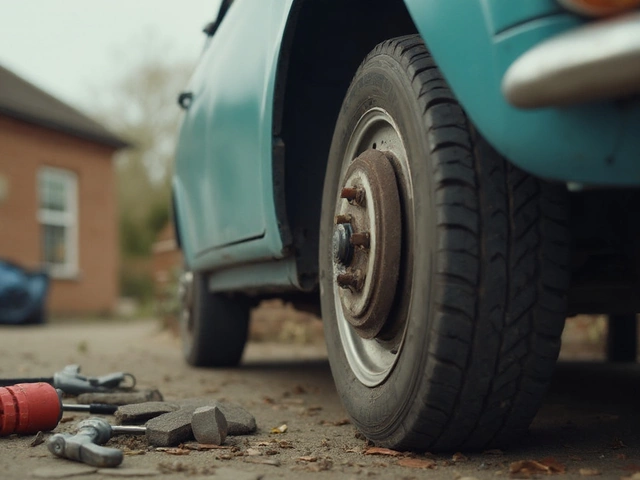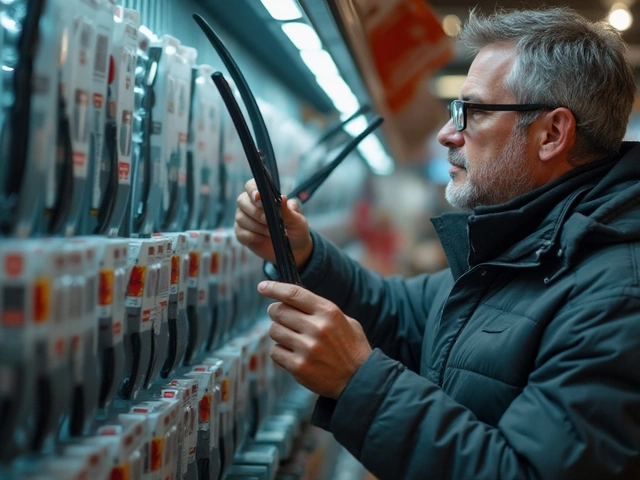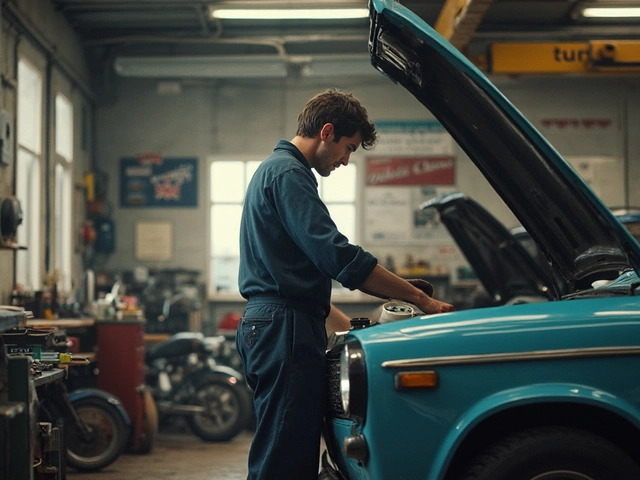Ensuring your view of the road ahead is crystal clear can be a game-changer, especially during those unexpected downpours. If you’ve ever found yourself squinting through a streaky mess while driving, you already know the importance of having the right windshield wipers.
Choosing the perfect pair for your vehicle doesn’t have to be a daunting task. Whether you go for traditional, beam, or hybrid wipers, the right choice depends on your car's model and your driving habits. In this article, we'll dive into the different types available, key features to identify quality wipers, and when to know it's time to swap them out.
Beyond picking the right ones, keeping them in top shape is essential. Learn easy installation techniques and how a little maintenance goes a long way in making those blades last, keeping you and your passengers safe on every journey.
- Understanding the Importance of Quality Wipers
- Types of Windshield Wipers Explained
- Signs Your Wipers Need Replacing
- Key Features to Look Out For
- DIY Installation Tips
- Maintaining and Extending Wiper Lifespan
Understanding the Importance of Quality Wipers
A clear windshield is more than just a convenience—it's an essential component for safe driving. The significance of having quality windshield wipers cannot be overstated, particularly when faced with adverse weather conditions. Visibility is everything when you're on the road, and reliable wipers ensure that rain, sleet, or snow are swiftly cleared from your line of sight. Interestingly, a study by the Automobile Association found that around 90% of driving decisions rely on a clear view of the road. This statistic alone highlights why having the right wipers is crucial.
Windshield wipers are not just for rain; they can also help clear debris, dust, and even bugs that smear across your windshield. Imagine driving through a beautiful countryside in summer, only to have your view marred by a cluster of insects. Quality wipers sweep such obstructions away with ease, ensuring you enjoy the scenery and stay aware of potential hazards. A single lapse in clarity can mean the difference between braking in time and a potentially dangerous situation.
Moreover, modern wipers have been designed for durability and efficiency, lasting longer and performing significantly better than older models. The right wipers can also reduce wear on your windshield, as poor quality blades might scratch or otherwise damage the surface. Considering the cost of replacing a windshield compared to that of a new set of wipers, investing in quality wipers seems not only wise but essential. According to Consumer Reports, replacing wiper blades can be one of the easiest and most cost-effective ways to enhance your vehicle's safety features.
“Visibility in driving conditions is non-negotiable. Your safety and the safety of those around you depend on it.” – National Highway Traffic Safety Administration
When it comes to quality wipers, they must fit the vehicle properly and perform according to the driver's environmental needs. Someone living in a rainy climate might prioritize blades designed for heavy precipitation, while a driver in a colder region might opt for ones that perform better during extreme winters. Many contemporary wipers have features like water-repellant coatings or aerodynamic designs that reduce drag and noise, further enhancing the driving experience.
In conclusion, while it might be tempting to overlook the importance of high-quality windshield wipers, doing so can compromise not only your safety but also the well-being of other road users. Whether it means spending a few extra pounds on better blades or taking the time to ensure they are well-fitted and maintained, these small steps can yield significant benefits, both in safety and in peace of mind. So next time you're behind the wheel, consider how well your wipers serve you in achieving a clear, safe, and enjoyable drive.
Types of Windshield Wipers Explained
When it comes to maintaining clear visibility on the road, choosing the right windshield wipers is essential. The variety of wiper blades available might seem overwhelming at first, but understanding the differences is simpler than you think. It boils down to three primary types: conventional, beam, and hybrid. Each of these types offers unique features tailored to different driving needs and conditions, making it important for car owners to identify which suits them best.
Conventional wipers, also known as frame-style wipers, have been around for decades. These are what most vehicles originally come equipped with. They consist of a rubber blade supported by a metal framework. These blades are generally effective for mild weather conditions, owing to their simplicity and cost-effectiveness. However, their performance can dip during heavy snow due to the framework potentially collecting ice and snow, which may hinder the blade's ability to make full contact with the windshield.
Beam Wipers
The modern age of automotive technology has given rise to beam wipers, which have quickly gained popularity among drivers looking for better performance in various weather conditions. Beam wipers stand out due to their sleek, frameless design, which enables them to maintain uniform pressure across the windshield. This innovative design considerably minimizes streaks and enhances durability. Notably, beam wipers shine in harsh weather conditions, proving especially reliable in heavy rain and snow. A report from AAA reveals that beam blades tend to last around 40% longer than conventional wipers, providing a worthy return on investment for their higher price point.
Hybrid Wipers
For drivers seeking the best of both worlds, hybrid wipers offer a compelling choice. These ingenious design solutions merge the robust construction of conventional wipers with the performance advantages of beam blades. Hybrid blades are equipped with an outer shell to protect the inner frame and blade from environmental elements, ensuring optimal functionality. Their reinforced rubber blades, when combined with this protective casing, perform admirably under challenging weather, making them a favorite for those who experience varied climates throughout the year. According to Michelin, a leading wiper blade manufacturer, hybrid wipers often provide the best balance of performance and longevity, making them an excellent choice for a wide range of vehicles.
Choosing the right wiper often comes down to individual preference and the specific climate you live in. Each type of wiper blade has distinct advantages that cater to different needs, so take the time to assess what's best for both you and your vehicle. Whether you're battling the relentless showers of an English spring or the snowy landscapes of winter, the right wiper blades can make all the difference in ensuring your safety and comfort on the road.

Signs Your Wipers Need Replacing
Have you ever noticed those annoying wiper marks on your windshield right after a downpour, obstructing that perfect view of your drive? That's one of the tell-tale signs that you might need new windshield wipers. When your wipers are leaving streaks rather than clearing up your view, it's pretty much like they've left you on read. You don’t want that, especially when you’re relying on them for safety. Wipers should glide silently and smoothly. Hearing a heartbreaking squeak or a stuttering motion indicates worn-out rubber or misaligned blades. When this happens, your visibility is compromised, turning every drive into a guessing game.
"Properly functioning wiper blades are critical for safety and driving confidence," emphasizes the Automobile Association in a 2023 study.
Another significant sign is when the blades themselves are visibly damaged. Look out for cracks or missing pieces; this indicates the rubber edge has seen better days. Blades degrading over time due to sun exposure might leave you with a dry, brittle piece of equipment that serves you nothing but heartbreak. It's natural for blades to last around six months to a year, but environmental conditions can accelerate their wear. This is especially true if your vehicle sits outside frequently. Snow, intense sunlight, or pesky tree sap can deteriorate even the most robust wipers. Moldy or discolored rubber is also a red flag, as it means your wipers aren't up to their task anymore.
Even if they pass the eye test, wipers that skip on the windshield aren't optimal. Sometimes debris accumulates under the blade, causing an uneven surface. This is particularly dangerous during those sudden showers that Bristol is famous for. Ever had your wipers jump around like a squirrel on caffeine? That's usually due to uneven pressure distribution, resulting in the wipers losing consistent contact with the glass. It inevitably leaves behind cloudy streaks, and we all know how distracting that can be. Also, be wary of rusting hardware, which can be hazardous, ultimately causing the blade to detach from the arm. If your blades are struggling to clean even mild debris off the windscreen, they’ve most likely overstayed their welcome.
What you might find intriguing are the dual-layered blades. The inner layer provides structural support, while the outer one works tirelessly to clear your windshield. Over time, if either layer fails, the efficiency plummets, leaving you squinting into the horizon. The transition from smooth to streaky isn't just inconvenient; it's potentially dangerous, especially during nighttime or stormy drives. Don't wait until it becomes a hazard. Consider keeping a pair of quality wipers as a backup in your boot. When it comes to car maintenance, it's always wiser to stay ahead of the problem than to react to it. Your future self, seated behind the wheel during a torrential shower, will thank you for it. Stay proactive, stay safe!
Key Features to Look Out For
When it comes to picking out windshield wipers that will reliably clear your view, certain features can make all the difference. One of the first factors to consider is the material of the wiper blade. Most blades are made from rubber, but there's a distinction between natural and synthetic rubber. Natural rubber provides excellent noise reduction and superior wiping performance, yet it may wear out quicker than synthetic rubber, which excels in resilience and longevity. So, your choice can heavily depend on your driving environment and how often you use your wipers.
The construction and design of the blade are also crucial. Traditional frame-style wipers have a metal frame that holds the rubber blade. They are affordable and suitable for everyday use. However, in the ever-evolving world of car maintenance, beam wipers offer a modern alternative. They have no external skeleton, which minimizes ice and snow build-up. For drivers who face harsh winters, this design feature can be a game-changer, providing uninterrupted performance in the most challenging weather.
The Importance of Size
Size is another significant factor. Wipers that are either too long or too short can lead to improper coverage or even damage to the wiper mechanism. Knowing the correct size for your vehicle is essential. Typically, a visit to your car’s service manual or an online search using your vehicle's make, model, and year will provide accurate sizing details. The wiper length can vary between different sides of the windshield, with the driver's side often requiring a longer blade to maximize the field of vision.
"The right windshield wipers are crucial for safe driving, offering visibility improvements that are essential, especially during adverse weather," asserts the National Highway Traffic Safety Administration.
Another often-overlooked detail is attachment compatibility. Wipers come with different types of mounts like J-hooks, Bayonet arms, or Pin arms. Ensuring the wiper blade has a compatible mount with your vehicle is crucial to avoid any inconveniences during installation. Modern brands sometimes include multiple adaptors that fit several kinds of arms, adding a welcome layer of versatility.
Additional Features and Innovations
In recent years, innovations in the design and functionality of wiper blades have emerged. For instance, some premium blades incorporate a protective coating. This helps in repelling water and ensuring a streak-free wipe, which can be especially handy during heavy rainfall. While such features come at a higher price point, the increase in visibility and safety they offer often justifies the cost for many drivers.
Ultimately, understanding these features can transform a simple act of purchasing wipers into a strategic decision that enhances your driving experience. With the right set of wipers, each drive, from the mundane to the exciting, becomes a little safer and a lot clearer.

DIY Installation Tips
Installing new windshield wipers on your vehicle can seem intimidating at first glance, but with a little know-how, it's a task anyone can accomplish. First, ensure you purchase the correct size for your vehicle. You can find this information in your car’s manual or often on the packaging of the wipers themselves. Once you have the right ones, start by lifting the wiper arm away from the windshield. Most cars today have a small tab underneath the wiper blade where it connects to the arm. Pressing this tab allows you to slide the old blade off easily. Sounds simple enough, right? Well, it's not always a smooth process, particularly if the blade is old and brittle. Patience and care can prevent unnecessary damage to the wiper arm—a delicate part of your car.
Now for the new blades. Begin by taking the new wiper out of its packaging. With modern windshield wipers, there might be adapters included, as not all cars use the same mounting system. It’s crucial to check you’re attaching the right adapter for your blade. Slide the new blade onto the arm until you hear an audible click that signals it’s securely in place. Test the stability by giving it a gentle pull. If there’s movement, try re-installing it because securement is critical for effective operation. Now, gently lower the wiper arm back onto the windshield, taking care to prevent it from snapping back, which could damage the glass.
Common Pitfalls
One of the most common mistakes, especially for newcomers, is not removing the plastic protective cover from the rubber edge of the new wiper—ending up with streaky windows just a day after installation. It’s a typical oversight but easily avoided if you take a moment to double-check your work before leaving the parking lot. But it doesn’t end there; sometimes, even the proper installation won’t cut it. A poor-quality wiper may not fit precisely or might have a shorter lifespan, leading to inefficiency in a short time. Choosing recognized brands is usually a hedge against such issues.
Carl Turner, a noted automotive expert, once stated, \Maintaining and Extending Wiper Lifespan
Windshield wipers are like unsung heroes of rainy days and snowy mornings, tirelessly working to ensure we can see the road clearly. Yet, like any hero, they require some care to stay in peak condition. Keeping them in good shape not only saves you from that awkward, frantic fiddling at a red light but also ensures your safety on the road. Regular maintenance is crucial for extending the life of your wiper blades. Even high-quality wipers can develop issues over time due to factors like sun exposure, buildup of dirt or debris, and regular wear and tear.
The first step in car maintenance is simply to clean your windshield and wipers regularly. Dirt and dust that accumulate on the glass can greatly affect how well your wipers work. Use a soft, damp cloth soaked in soapy water to gently wipe down the rubber and remove any grime. Pay attention to the edges where dirt tends to build up. Cleaning them helps prevent the blades from cracking and tearing. This activity, when done consistently, is an easy step to keep the wiper blades functioning smoothly and effectively removing water and debris from the windshield.
Parking habits can also play a big part in how long your wipers last. If possible, try to park in a garage or shaded area to protect your wipers from the sun's harsh rays. Sunlight can cause the rubber on your wipers to deteriorate faster, leading to more frequent replacements. Similarly, in cold weather, it’s wise to avoid using your wipers to clear off ice and snow; instead, use a brush to gently remove heavy snow from your windshield before letting your wipers finish the job.
"Routine check-ups often extend the service life of windshield wipers by more than 50%," claims Dr. Lucy Meyer, a vehicle care expert.Finally, don’t underestimate the value of the right wiper fluid. Specialized winter fluids can help prevent ice from forming and sticking to blades, and summer blends often include solvents that help clean away bugs and road grime. The right fluid ensures that your wipers aren’t just smearing dirt around, but actually clearing and cleaning your windshield efficiently. By adopting these tips, you can help ensure your wipers provide optimal performance and longevity—their value extending beyond just keeping the rain off the glass, to enhancing your visibility and safety at all times.






